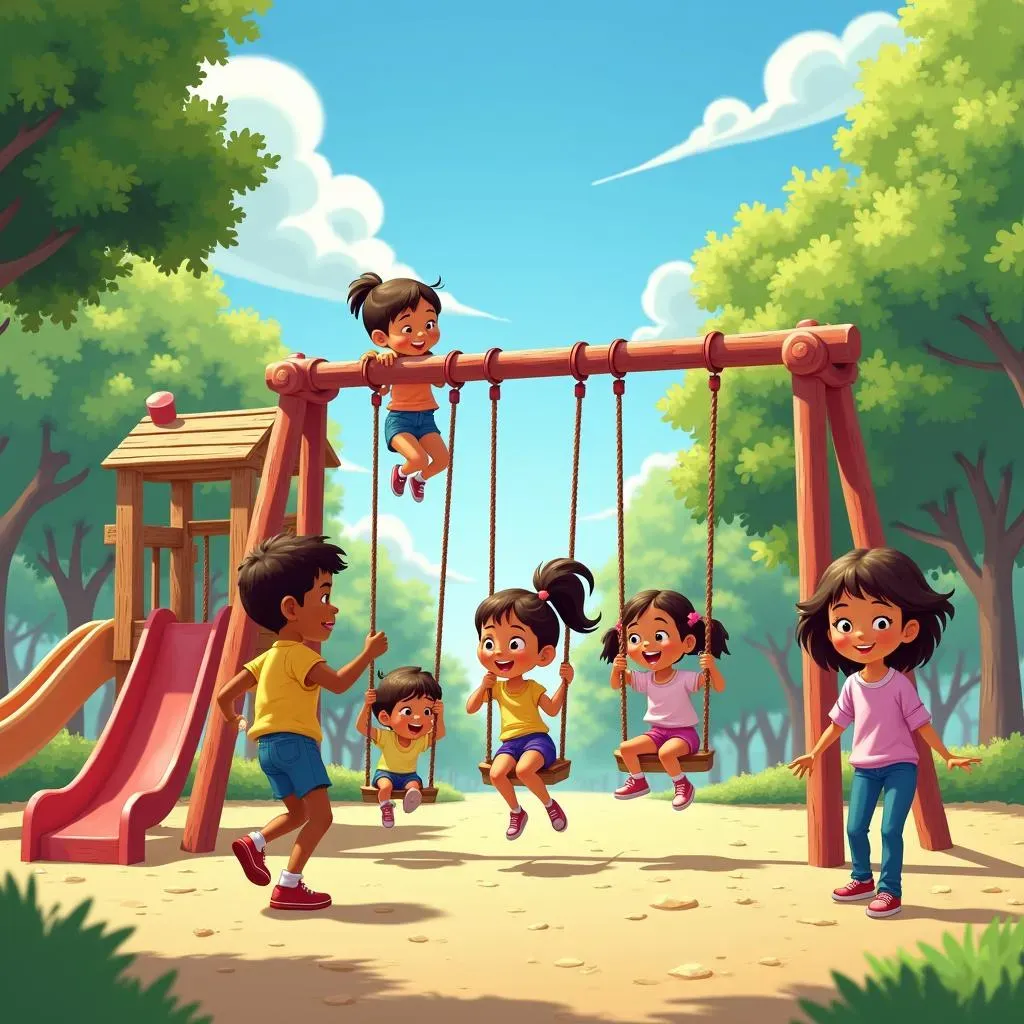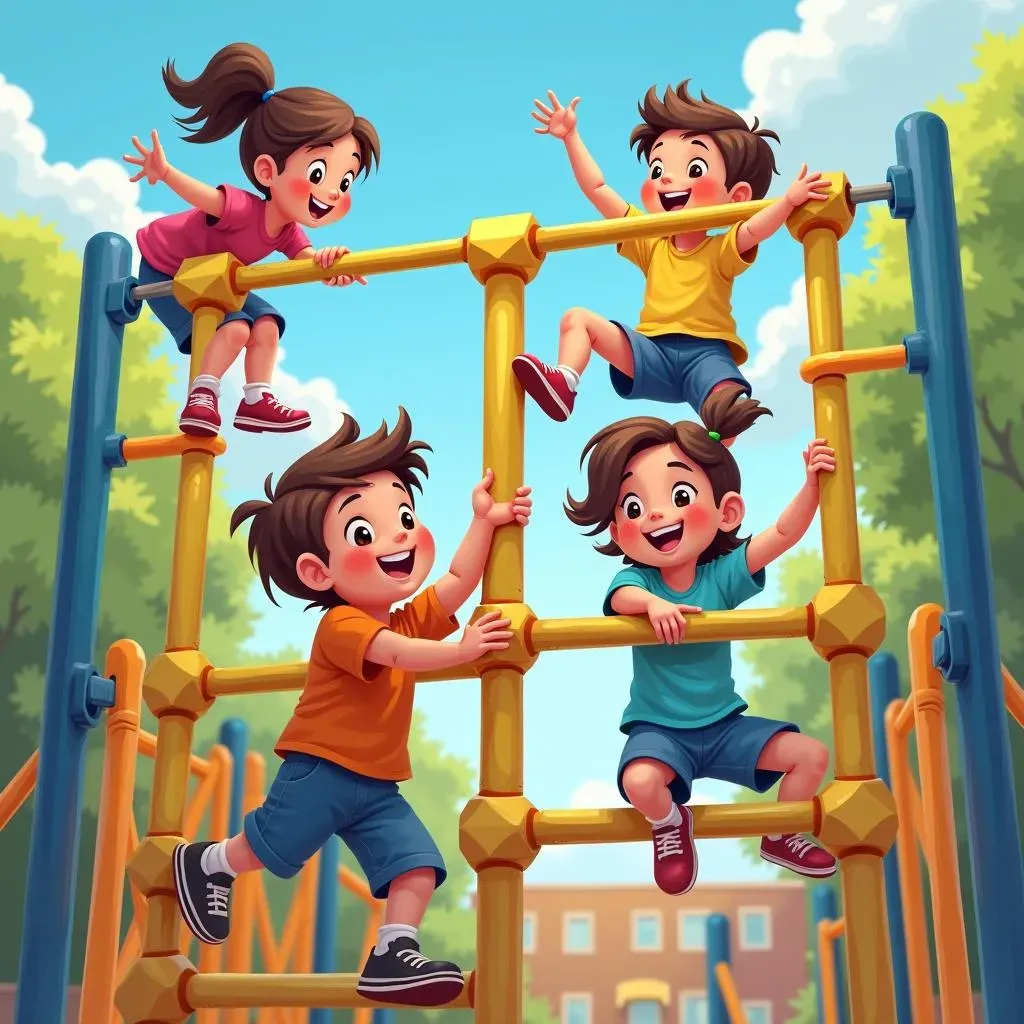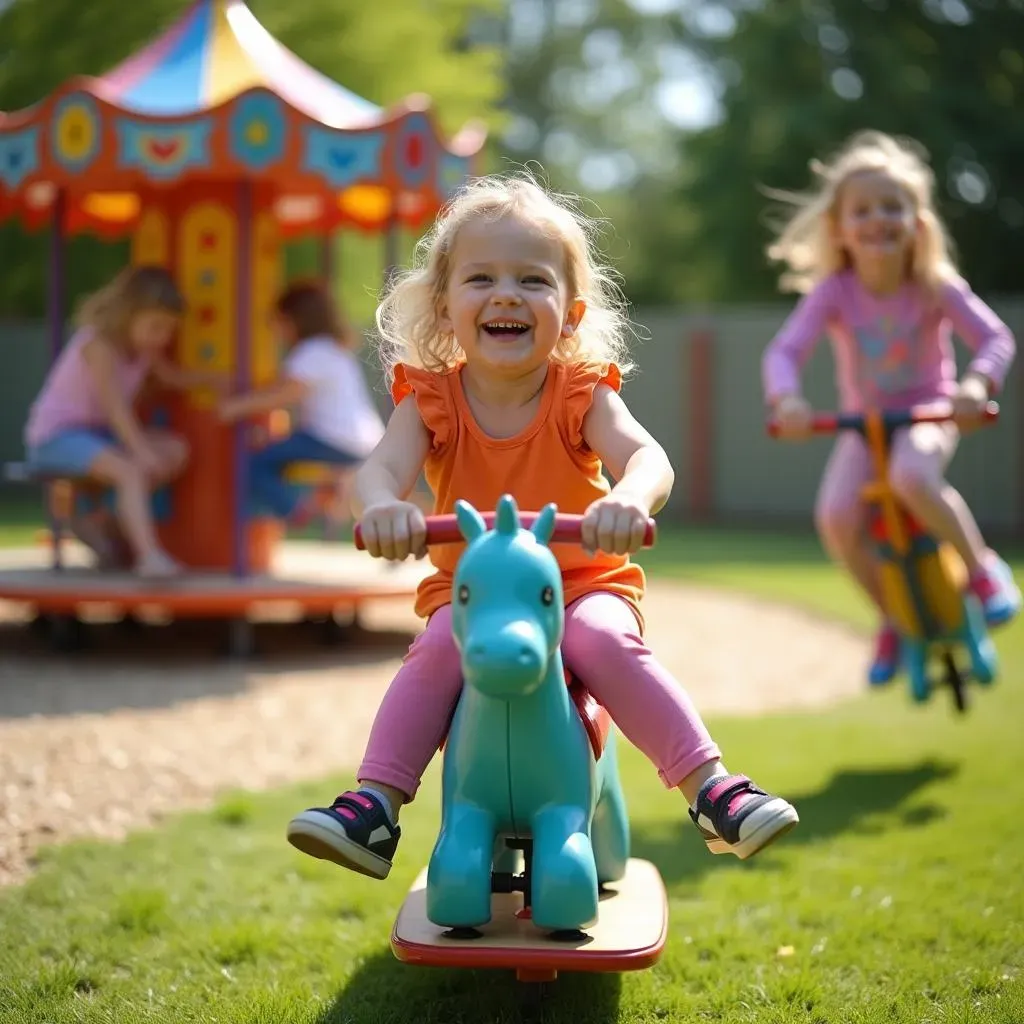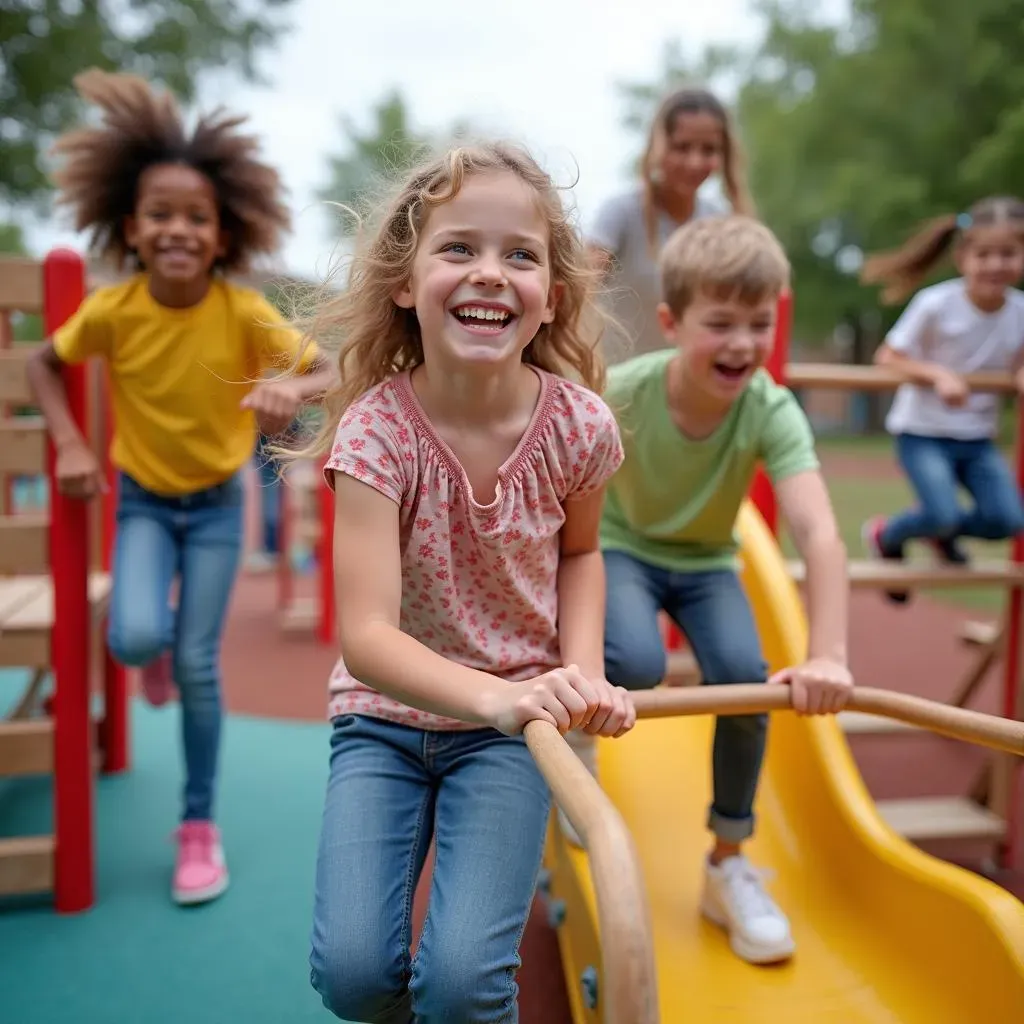Table of Contents
Ever wondered exactly what equipment is in a playground? Playgrounds are more than just spaces for kids to burn off energy; they're carefully designed environments packed with equipment that encourages physical activity, social interaction, and imaginative play. From the classic swing set that sends you soaring to the challenging monkey bars that test your strength, each piece of equipment serves a unique purpose in a child's development. In this guide, we'll embark on a tour of the playground, naming and describing the most common pieces of equipment you'll find. Whether you're a parent, educator, or simply curious, you'll gain a better understanding of the purpose and function of each element in these vital community spaces. So, let's jump in and explore the exciting world of playground equipment!
Swing Sets and Slides: Classic Playground Staples

Swing Sets and Slides: Classic Playground Staples
No playground is complete without the timeless duo of swing sets and slides. These aren't just random pieces of equipment; they're fundamental to childhood development, offering a blend of fun and physical activity that's hard to beat. Swing sets, with their rhythmic back-and-forth motion, provide a sense of freedom and exhilaration. They also help develop gross motor skills, coordination, and balance. Slides, on the other hand, offer a thrilling descent that builds courage and spatial awareness. From simple straight slides to winding, enclosed tubes, there's a slide for every level of adventure seeker.
But did you know that the history of these playground staples goes way back? Swings have been around for centuries, evolving from simple ropes hanging from trees to the more complex metal and plastic structures we see today. Slides, too, have a surprisingly long history, with early versions appearing in the 19th century. These classics have stood the test of time for a reason: they’re universally appealing and provide essential developmental benefits.
Equipment | Benefit | Fun Factor |
|---|---|---|
Swing Sets | Develops gross motor skills, coordination, and balance | High |
Slides | Builds courage and spatial awareness | High |
Climbing Structures and Monkey Bars: Enhancing Strength and Coordination

Climbing Structures and Monkey Bars: Enhancing Strength and Coordination
Alright, let's talk about climbing structures and monkey bars – the unsung heroes of upper body strength and coordination! These aren't just metal or plastic contraptions; they're dynamic tools that challenge kids to push their physical limits while having a blast. Climbing structures come in all shapes and sizes, from simple ladders to complex geometric designs. They encourage kids to develop problem-solving skills as they figure out the best way to navigate the structure. Monkey bars, on the other hand, are a classic test of grip strength and endurance. Swinging from bar to bar requires focus, coordination, and a good dose of determination.
Think about the sheer joy of reaching the end of the monkey bars for the first time. That feeling of accomplishment is priceless! Plus, these activities are fantastic for building confidence and resilience. Falling off the monkey bars is just part of the learning process. It teaches kids to get back up, dust themselves off, and try again. It’s a lesson that extends far beyond the playground.
Equipment | Skills Enhanced | Challenge Level |
|---|---|---|
Climbing Structures | Problem-solving, spatial awareness, gross motor skills | Medium to High |
Monkey Bars | Grip strength, endurance, coordination | High |
MerryGoRounds, SeeSaws, and Spring Riders: Fun for All Ages

MerryGoRounds, SeeSaws, and Spring Riders: Fun for All Ages
Whirling Wonders: The Merry-Go-Round
Let's spin into the world of merry-go-rounds! These whirling platforms are more than just a dizzying ride; they're a social hub where kids learn to coordinate their movements and cooperate to get the thing spinning. Remember the feeling of pushing off with your feet, the wind in your hair, and the collective giggles as everyone tries to hold on? Merry-go-rounds teach teamwork, spatial awareness, and a healthy dose of centrifugal force. They're a fantastic way to develop gross motor skills and create lasting memories.
But here's a little-known fact: early merry-go-rounds were often powered by animals or even steam engines! Thankfully, modern versions rely on good old-fashioned kid power. And while safety standards have evolved over the years, the core concept remains the same: a spinning platform that brings joy and laughter to all who dare to ride.
Balancing Act: The Classic See-Saw
Next up, let's balance things out with the see-saw! This simple yet ingenious piece of equipment teaches kids about physics, teamwork, and the importance of taking turns. The see-saw is a lesson in cause and effect: your weight affects your partner, and vice versa. It requires communication, coordination, and a willingness to compromise. It's also a fantastic way to develop core strength and balance.
Did you know that see-saws have been around since ancient times? Early versions were used for practical purposes, such as lifting water. Over time, they evolved into the playground staple we know and love today. And while the basic design has remained relatively unchanged, modern see-saws often incorporate safety features like springs and cushioned seats.
Bouncing Buddies: Spring Riders
Last but not least, let's hop into the world of spring riders! These bouncy, whimsical creatures bring a touch of imagination and fun to any playground. Whether it's a horse, a car, or a friendly animal, spring riders offer a gentle rocking motion that's perfect for younger children. They help develop balance, coordination, and imaginative play skills. Plus, they're just plain fun!
Spring riders are a relatively recent addition to the playground landscape, but they've quickly become a favorite among kids of all ages. Their bright colors and playful designs add a touch of whimsy to the playground, and their gentle motion provides a safe and enjoyable way for young children to develop their motor skills. So, next time you see a spring rider, hop on and let your imagination take flight!
Equipment | Skills Developed | Age Suitability |
|---|---|---|
Merry-Go-Rounds | Teamwork, spatial awareness, gross motor skills | Ages 5+ |
See-Saws | Physics, teamwork, communication, balance | Ages 5+ |
Spring Riders | Balance, coordination, imaginative play | Ages 2-5 |
Safety, Materials, and FAQs about Playground Equipment

Safety, Materials, and FAQs about Playground Equipment
Prioritizing Safety: Creating a Secure Play Environment
When it comes to playgrounds, safety is paramount. It's not just about avoiding injuries; it's about creating an environment where kids can explore, learn, and grow without unnecessary risk. That starts with proper surfacing. You know, the stuff under the equipment? It's gotta be impact-absorbent! Think engineered wood fiber, rubber mulch, or poured-in-place rubber. The depth of the surfacing matters, too. The higher the equipment, the thicker the surfacing needs to be. Regular inspections are a must. Look for hazards like broken equipment, loose bolts, and sharp edges. And don't forget about supervision. Adults play a crucial role in ensuring kids are using the equipment safely and following the rules.
Another key aspect of playground safety is age appropriateness. Not all equipment is suitable for all ages. Toddler areas should be separated from areas designed for older children. Make sure the equipment is properly installed and maintained. This isn't a DIY project! Hire qualified professionals to install and inspect the equipment. And finally, educate kids about playground safety rules. Teach them to take turns, avoid running in front of swings, and never climb on equipment that's too high for them.
Choosing the Right Materials: Durability and Sustainability
Let's dive into the materials that make up playground equipment. Gone are the days of all-metal playgrounds (ouch!). Today, you'll find a wide range of materials, each with its own pros and cons. Wood is a classic choice, offering a natural look and feel. It's durable, but requires regular maintenance to prevent rot and splintering. Metal, often powder-coated steel or aluminum, is strong and long-lasting. It's also relatively low-maintenance. Plastic, particularly recycled plastic, is becoming increasingly popular. It's weather-resistant, colorful, and environmentally friendly. Composite materials, a blend of wood and plastic, offer the best of both worlds: durability and low maintenance.
When choosing materials, consider the climate, the level of use the playground will receive, and your budget. Also, think about sustainability. Opt for recycled or renewable materials whenever possible. Look for certifications like the Forest Stewardship Council (FSC) for wood products. And don't forget about accessibility. Ensure the playground is inclusive and accessible to children of all abilities. This includes ramps, transfer stations, and adaptive equipment.
Material | Pros | Cons |
|---|---|---|
Wood | Natural look, durable | Requires maintenance |
Metal | Strong, long-lasting, low-maintenance | Can get hot in the sun |
Plastic | Weather-resistant, colorful, eco-friendly | Can fade over time |
Conclusion: Embracing the Playground Adventure
Now that you're equipped with the knowledge of what equipment is in a playground, you can appreciate these spaces even more. From the simple joy of a swing to the developmental benefits of climbing structures, playgrounds offer a world of opportunity for children. So, next time you visit a playground, take a moment to observe the different pieces of equipment and the ways children interact with them. Encourage exploration, foster creativity, and most importantly, embrace the adventure that awaits in every playground visit!